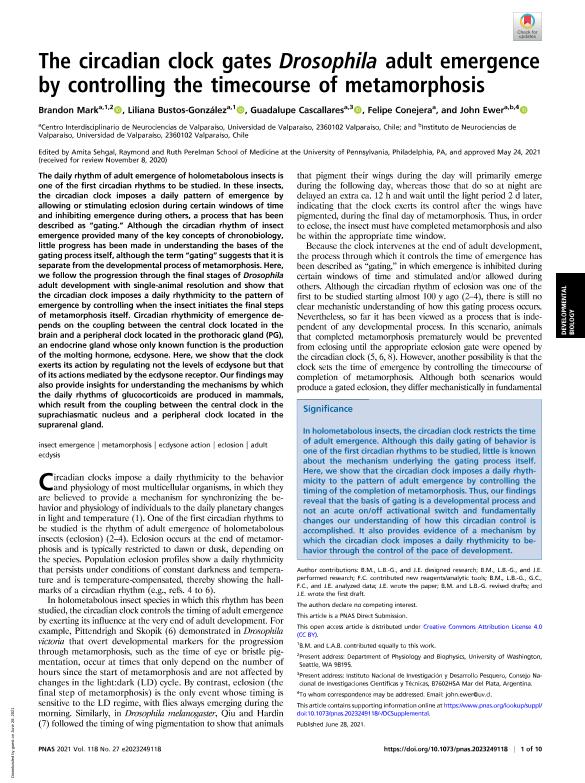Mostrar el registro sencillo del ítem
dc.contributor.author
Brandon, Mark Thomas

dc.contributor.author
Bustos González, Liliana
dc.contributor.author
Cascallares, Maria Guadalupe

dc.contributor.author
Conejera, Felipe
dc.contributor.author
Ewer, John
dc.date.available
2022-09-06T14:53:10Z
dc.date.issued
2021-07
dc.identifier.citation
Brandon, Mark Thomas; Bustos González, Liliana; Cascallares, Maria Guadalupe; Conejera, Felipe; Ewer, John; The circadian clock gates Drosophila adult emergence by controlling the timecourse of metamorphosis; National Academy of Sciences; Proceedings of the National Academy of Sciences of The United States of America; 118; 27; 7-2021; 1-10
dc.identifier.issn
0027-8424
dc.identifier.uri
http://hdl.handle.net/11336/167582
dc.description.abstract
The daily rhythm of adult emergence of holometabolous insects is one of the first circadian rhythms to be studied. In these insects, the circadian clock imposes a daily pattern of emergence by allowing or stimulating eclosion during certain windows of time and inhibiting emergence during others, a process that has been described as “gating.” Although the circadian rhythm of insect emergence provided many of the key concepts of chronobiology, little progress has been made in understanding the bases of the gating process itself, although the term “gating” suggests that it is separate from the developmental process of metamorphosis. Here, we follow the progression through the final stages of Drosophila adult development with single-animal resolution and show that the circadian clock imposes a daily rhythmicity to the pattern of emergence by controlling when the insect initiates the final steps of metamorphosis itself. Circadian rhythmicity of emergence depends on the coupling between the central clock located in the brain and a peripheral clock located in the prothoracic gland (PG), an endocrine gland whose only known function is the production of the molting hormone, ecdysone. Here, we show that the clock exerts its action by regulating not the levels of ecdysone but that of its actions mediated by the ecdysone receptor. Our findings may also provide insights for understanding the mechanisms by which the daily rhythms of glucocorticoids are produced in mammals, which result from the coupling between the central clock in the suprachiasmatic nucleus and a peripheral clock located in the suprarenal gland.
dc.format
application/pdf
dc.language.iso
eng
dc.publisher
National Academy of Sciences

dc.rights
info:eu-repo/semantics/openAccess
dc.rights.uri
https://creativecommons.org/licenses/by/2.5/ar/
dc.subject
ADULT ECDYSIS
dc.subject
ECDYSONE ACTION
dc.subject
ECLOSION
dc.subject
INSECT EMERGENCE
dc.subject
METAMORPHOSIS
dc.subject.classification
Biología del Desarrollo

dc.subject.classification
Ciencias Biológicas

dc.subject.classification
CIENCIAS NATURALES Y EXACTAS

dc.title
The circadian clock gates Drosophila adult emergence by controlling the timecourse of metamorphosis
dc.type
info:eu-repo/semantics/article
dc.type
info:ar-repo/semantics/artículo
dc.type
info:eu-repo/semantics/publishedVersion
dc.date.updated
2022-08-16T20:37:11Z
dc.identifier.eissn
1091-6490
dc.journal.volume
118
dc.journal.number
27
dc.journal.pagination
1-10
dc.journal.pais
Estados Unidos

dc.journal.ciudad
Washington D.C
dc.description.fil
Fil: Brandon, Mark Thomas. Universidad de Valparaíso; Chile. University of Washington; Estados Unidos
dc.description.fil
Fil: Bustos González, Liliana. Universidad de Valparaíso; Chile
dc.description.fil
Fil: Cascallares, Maria Guadalupe. Consejo Nacional de Investigaciones Científicas y Técnicas. Centro Científico Tecnológico Mar del Plata. Instituto de Investigaciones Marinas y Costeras. Subsede Instituto Nacional de Investigación y Desarrollo Pesquero; Argentina. Universidad de Valparaíso; Chile
dc.description.fil
Fil: Conejera, Felipe. Universidad de Valparaíso; Chile
dc.description.fil
Fil: Ewer, John. Universidad de Valparaíso; Chile
dc.journal.title
Proceedings of the National Academy of Sciences of The United States of America

dc.relation.alternativeid
info:eu-repo/semantics/altIdentifier/doi/http://dx.doi.org/10.1073/pnas.2023249118
dc.relation.alternativeid
info:eu-repo/semantics/altIdentifier/url/https://www.pnas.org/doi/full/10.1073/pnas.2023249118
Archivos asociados
